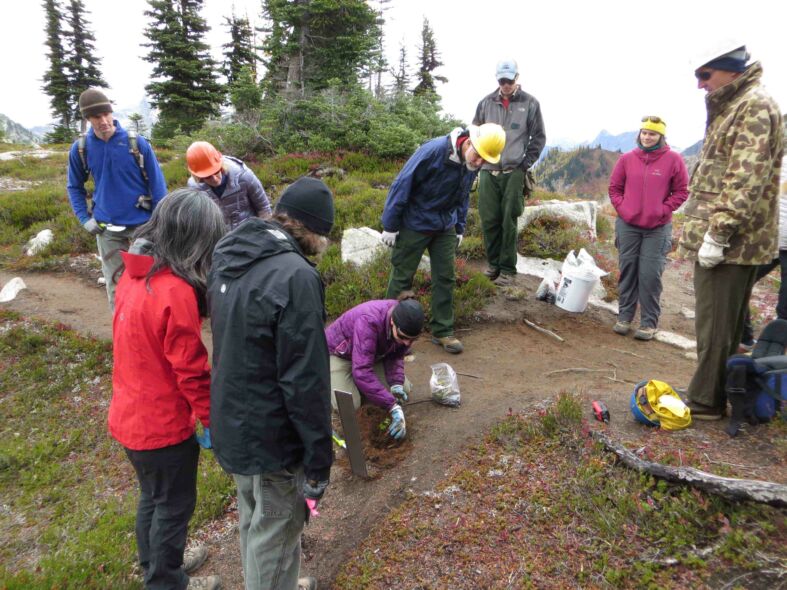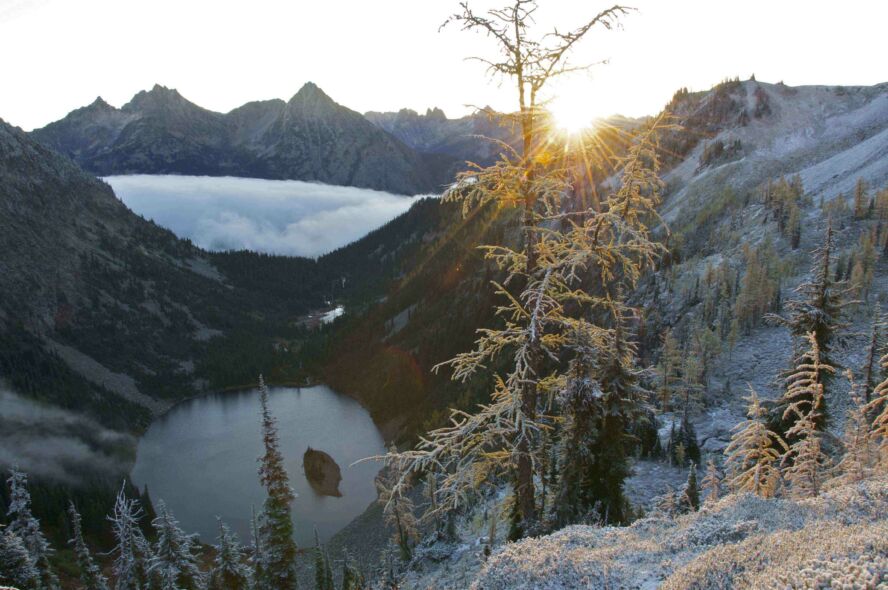The National Forest Foundation’s first-ever “Plant-and-Camp” volunteer weekend up high in the Cascades, on the Okanogan-Wenatchee National Forest’s Maple Pass trail, was off to an early start: at 6:30 am on Saturday, September 26, I met the Methow Valley Ranger District (“MVRD”) botanist, two members of the fire hand crew, and a local high school student documenting the event as her senior project, at the Ranger Station.
We were headed up into the mountains in advance of two-dozen volunteers to assist in the scheduled helicopter-delivery of hundreds of pounds of plants and supplies to the top of the Maple Pass trail.

Photo by Natalie Kuehler.
Hiking up the Maple Pass trail in the early morning clouds.
This volunteer weekend, part of the NFF’s Treasured Landscapes: Majestic Methow campaign, was particularly important to me. I had hiked the trail dozens of times over the last few months, marveling at the stunning views and cringing at the sight of countless user trails through fragile meadows. The loop had only been completed in 1993, and already there were large spots that had been entirely denuded by hikers straying off the trail. The area was, truly, being loved to death.
What is worse, hikers were damaging alpine heather communities that, unbeknownst to most people, took as many as 7,000 years to establish themselves. A single user-trail can alter the water flow and, over time, cause the entire community to perish.
Earlier this season we had:
- roped areas off,
- created free maps and educational brochures available at the trailhead,
- given presentations about the fragility of heather plants, and
- erected trail signage.
This weekend, however, was going to be the big one: With the help of volunteers we were going to eliminate user-trails and jump start new growth by planting thousands of plants meticulously grown out at a National Park Service greenhouse.
What we needed now was some clear weather so the helicopter could fly. When we jumped out of the cars at the trailhead, however, we were immediately engulfed by heavy, wet clouds. We shook droplets of rain off our gear and told each other this was great, after all we needed moist soil for the plants, and surely the clouds would part by the time the helicopter was scheduled to take off. And so we bounded up the trail, each carrying heavy overnight packs so we could spend the night up on the trail – otherwise closed to camping. This would allow us and the volunteers to work late into the evening and start again early the next day.
Ninety minutes later we arrived at the first of two helicopter drop sites nearly 2,000 feet above the trailhead – but still well within the clouds. We confirmed over the radio that Mike Liu, the District Ranger, had gathered up over a dozen volunteers and was leading the hike up; a perfect gesture of support on National Public Lands Day. The helicopter, however, was still grounded. Finally, we got concerned. What if the clouds would never part? How would we restore the area without any tools, much less the 3,500 plants?












